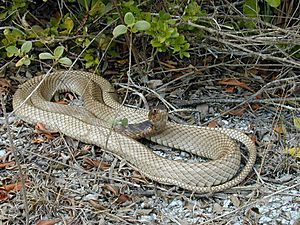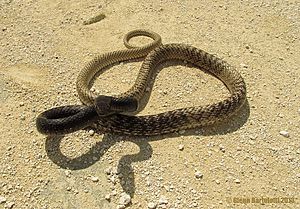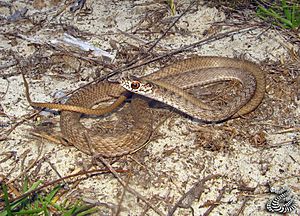Eastern coachwhip facts for kids
Quick facts for kids Masticophis flagellum flagellum |
|
|---|---|
 |
|
| Eastern coachwhip Masticophis flagellum flagellum |
|
| Conservation status | |
| Scientific classification |
|
| Kingdom: | Animalia |
| Phylum: | Chordata |
| Class: | Reptilia |
| Order: | Squamata |
| Suborder: | Serpentes |
| Family: | Colubridae |
| Genus: | Masticophis |
| Species: | |
| Subspecies: |
M. f. flagellum
|
| Trinomial name | |
| Masticophis flagellum flagellum Shaw, 1802
|
|
| Synonyms | |
|
|
The Eastern coachwhip (scientific name: Masticophis flagellum flagellum) is a type of snake. It is a subspecies of the coachwhip snake. These snakes are not venomous, meaning they don't have poison. They are a kind of colubrid snake, which is a large family of snakes. Eastern coachwhips live only in the southern United States.
Contents
Where Eastern Coachwhips Live
Eastern coachwhips can be found across a wide area. They live from North Carolina all the way down to Florida in the east. In the west, you can find them from eastern Kansas to eastern Texas. Interestingly, they are not found in the Mississippi Delta area. This means their population is split into two main groups.
What Eastern Coachwhips Look Like
Adult Eastern coachwhips are long and thin. They usually grow to be about 50 to 72 inches (127 to 183 centimeters) long. The longest one ever recorded was an amazing 102 inches (259 centimeters) long! This makes them one of the biggest native snakes in North America.
Their head and neck are often black. This dark color usually fades into a tan color further down their body. Some snakes might not have the dark head and neck at all. Their scales are smooth, and their coloring can make them look like a braided whip. This is how they got their common name, "coachwhip."
Where Eastern Coachwhips Like to Live
These snakes can live in many different places. However, they are most common in the southeastern coastal plain. They especially like sandy pine forests and areas with pine trees and palmetto plants. You might also find them in cedar glades, or near creeks, marshes, and swamps.
How Eastern Coachwhips Behave and What They Eat
The Eastern coachwhip is a very active and fast snake. It is diurnal, which means it is active during the day. It hunts for its food using both its sense of smell and its eyesight.
It often hunts with its head held up high above the ground and plants. Unlike many other snakes, it actually watches its prey carefully before catching it. Once it catches something, the snake swallows its prey alive. They have strong jaws with many small teeth that point inward. Sometimes, they have been seen hitting their prey against the ground. This might be to stun the prey before swallowing it. Eastern coachwhips eat many different things, including birds, large insects, lizards, other snakes, and small mammals.
Eastern Coachwhip Babies
Eastern coachwhips mate in the spring. The female snake will lay a group of 10 to 16 eggs in June or July. She usually lays her eggs in rotting plants or logs. The baby snakes hatch after about 6 to 11 weeks. When they first hatch, they are about 12 to 16 inches (30 to 41 centimeters) long.
A Common Myth About Coachwhips
There's a common story that Eastern coachwhips will attack people and whip them with their tails. This is not true! When these snakes are bothered, they usually try to get away very quickly. Sometimes, they might vibrate the tip of their tail in the leaves on the ground. This can make a sound that sounds a bit like a rattlesnake. If a coachwhip feels trapped, it will defend itself. It might strike repeatedly and bite to protect itself.




